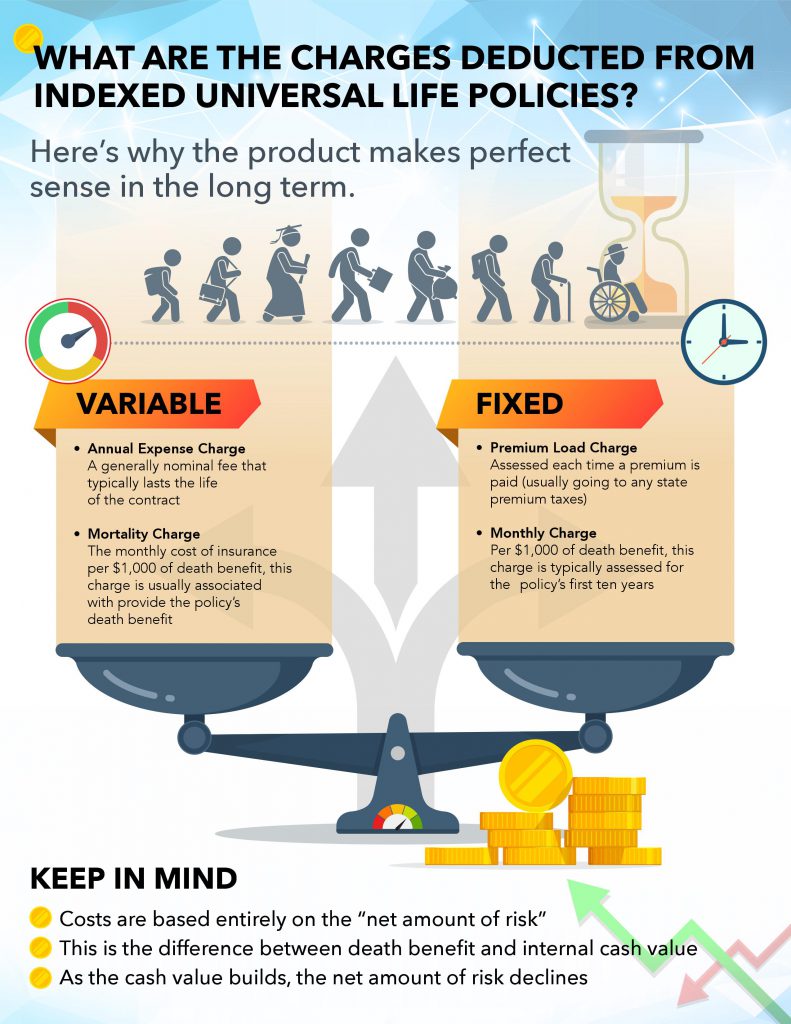Updated on April 4. 2024, at 12:59 PM
Charges deducted from indexed universal life (IUL) policies can turn off potential buyers. But why? The number one argument I hear when reviewing a life insurance policy designed for cash accumulation is, “It’s a terrible investment because the costs are just too high.”
But it this really true for IUL policies?
If you went and conducted a Google search on IUL costs you would probably find several articles written by someone who is trying to sell you other vehicles. Perhaps a mutual fund or a whole life over an IUL.
This article and infographic aim to educate you on what the true costs are with IULs and why these contracts may make perfect sense for the long term.
Check out the IUL infographic below for more details.
Charges Deducted from Indexed Universal Life Policies
There are typically four different charges deducted from indexed universal life policies. We can break these down into fixed and variable expenses. The fixed are the premium load and the monthly charge, while the variable ones are the expense charge and the mortality charge.
The premium load charge is assessed each time a premium is paid, usually going to any state premium taxes. The monthly charge per $1,000 of the death benefit is typically only assessed for the first 10 years after the policy is issued. This is usually front-loaded and goes towards the acquisition costs that the insurance company has. Whether that’s all the medicals they must order, getting doctor’s records, or even paying compensation to the advisors.
The third charge is a (generally nominal) annual expense charge. This’ll typically last for the life of the contract. The fourth charge—the monthly cost of insurance per $1,000 of death benefit—is the mortality charge associated with providing the policy’s death benefit.
Related: A Look At IUL Fees, Costs, & Illustration Manipulation

Cost Based on Risk
The most important thing to keep in mind with regards to this cost is it is entirely based on the “net amount of risk”, which is the difference between the death benefit and the internal cash value. As the cash value builds in the contract the “net amount of risk” will decrease.
Related: IUL vs. Whole Life Insurance: What are the Differences?
Life insurance contracts are usually heavily loaded with costs in the early years. Specifically, when clients are still paying the monthly charge per thousand and the “net amount of risk” is higher.
Therefore, when selling these for the opportunity of cash accumulation, we must all understand that this is a long-term play. The costs are significantly higher early on, but much lower in the later years. Unfortunately, that’s when clients usually need the money the most.
Bottom Line
The fact is that an IUL is a life insurance contract and already provides a death benefit. What’s more, its cash value grows tax-deferred, can be accessed tax-free. AND there may be the opportunity for growth with certain protections from downside swings in the market. Some even offer uncapped potential.
Simply put, a properly structured IUL may prove to be a potential tool for retirement income purposes.



